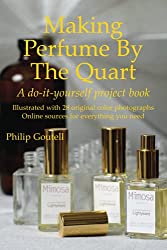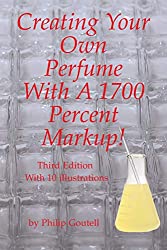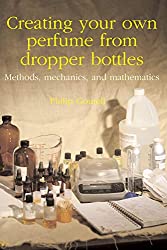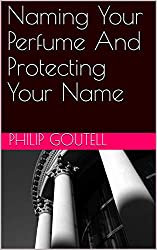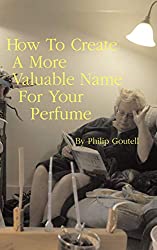Into the big bottle: final production of the first batch of a new perfume

32-ounce bottle filled above the shoulder with my new perfume. This is dangerous as hot weather can cause the fragrance to expand and blow the cap off the bottle. Surrounding the big bottle are the 1-ounce bottles used when weighing out the formula from drops into grams.
I have been writing about a new perfume I'm developing. You can read some of my previous messages here, here, and here. Finally I have bottled a batch of the finished fragrance (on 06/03/2020). The finished fragrance is a mixture of oil, alcohol, and water. I produced just over 1 liter, which is just over 32 ounces.
My plan is to present the finished fragrance in 1-ounce bottles. If there were no such things as spillage and waste I would be able to fill 32 bottles. But there will be waste. I'll be lucky to fill 28 bottles with what I've got. Of course I'll try to be as careful as possible and maybe I'll get one, or even two more filled, but I'm not counting on it.
The big bottle shown above is really just the opening event. The fragrance in the 32 ounce bottle simply confirms the scent I wanted to achieve and its quality. To produce it I worked from a formula in percentages and, with that same formula, I can produce or have produced for me, any quantity of this fragrance I need.
As mentioned in my previous article, the mixture going into the big bottle is 7-1/2 percent oil (the scent itself) and 92-1/2 percent alcohol and the alcohol is 90 percent pure ethanol and 10 percent water (de-ionized water as I use for all my fragrances.)
My starting point for this small, "laboratory scale," production run was measuring the amount of oil I had on hand. This came to 80 ml (milliliters). From here the math told me that if my 80 ml of oil were to be 7-1/2 percent of the total mixture, alcohol and water (92-1/2 percent) would come to 986 ml. Ten percent of 986 ml (98.6 ml) would be water and the remaining 887.4 ml would be "100 proof" alcohol.
Can you see the problem I now face?
My mixture, as planned, will be 80 ml oil, 98.6 ml water, and 887.4 ml alcohol. If a larger batch was being made and the work was being done at a professional fragrance house, these numbers would present no problem. But I'm working with simple equipment. Granted I've spent a few hundred dollars for my lab equipment, but it's not going to allow me to make such precise measurements.
To be practical, I've rounded up the amount of water to 99 ml. On a 150 ml beaker this will bring me just under the 100 ml mark. For the alcohol I'll round down from 887.4 ml to 887 ml. Now my production mix list is 80 ml oil, 99 ml water, and 887 ml alcohol for a total of 1066 ml or 1.066 liters.

150 ml beaker next to 1-ounce bottle.
To make measurement of the alcohol more precise, I used a 4-cup measuring cup to measure out the first 800 ml of alcohol. The cup had an 800 ml mark so that was easy to get right. For the remaining 87 ml of alcohol I again used my 150 ml beaker (shown here.) There's a 80 ml mark (without the number) and I just went a bit over it. In this case I believe this would give me acceptable accuracy.
A warning note. When you are producing your fragrance in small quantities such as I've done here, look at your measurements before you start mixing. Make sure that you have a large enough container to hold everything you're putting into the mix. In my example, I almost went over the limit by putting more than 32 ounces into a 32 ounce bottle. Fortunately bottles have a bit of extra space above the shoulder to allow for expansion. BUT, when you start to fill this space, you risk blowing the cap off on a hot day when the fragrance expands. In this case I'm keeping the fragrance close to room temperature for the next 30 days while the elements blend and I plan to start filling my 1-ounce perfume bottles before the hottest days of summer arrive.
For supplies used in the development of this fragrance, visit the Vendors section of this website.
Also available in a soft cover edition from Amazon. — or read more about this book.
Homemade perfumes generally lack commercial value, regardless of how wonderful they may be, because their creators fail to record how their perfumes were made. To profit from a perfume, to sell it, to sell the rights to it, or have somebody sell it for you, you must be able to make more of it. To make more you need the formula, the record of how the perfume was made: what materials were used and how much of each material was used. While the formula is nothing more than a recipe, a simple piece of paper, it is the key to unlocking your perfume's commercial potential. With the formula in your hand you have the ability to make a few dozen bottles more or, like the celebrities, tens of thousands of bottles. How to create an international production formula for your homemade perfume is a guide to getting you started on the right foot, correctly documenting everything you do as you are doing it, and then using these notes with some basic mathematics to write a simple, accurate, universal formula for your perfume. Writing formulas for your perfumes can change the way you think about them. With your formulas in hand your creations are no longer "here today, gone tomorrow." Now, thanks to your library of formulas, your perfumes become immortal!
While much is written about perfume – the beautiful fragrances... the beautiful bottles – little is available on the "mechanics" of perfume production – the steps that take place on the "factory floor" where a beautiful vision is turned into a finished product, a "ready to sell" perfume. Now you can experience all of these steps, hands on, by making just one quart of your own perfume. If you follow each chapter and do what you are instructed to do, you will end up with from 8 to 64 bottles of your own perfume, depending on the capacity of the bottles you select. Along this "insiders journey," each step is profusely illustrated with professional color photographs and you'll learn — • Exactly what alcohol you'll need and where to get it • Why you'll want (just a little!) water in your perfume • What type bottles you'll need and why you cannot use others • Why you will use a spray and not a cap • How to fill and seal your bottles • How to label your bottles with the correct information so they will be legal for sale • How to select a name for your perfume that will allow you to acquire powerful trademark rights free. If you are a developer of scents you are encouraged to use one of your own for this project. If you are not a scent creator yourself you'll learn how to get a fragrance oil that is exactly right for this project. Online sources are given for all required supplies and materials. Nothing can hold you back from starting your project immediately!
Perfume is famous for the markup it can achieve, even for a middle market fragrance. While "everybody knows" that perfume costs next to nothing to make (not completely true) the making of it is often considered an esoteric secret. "Creating Your Own Perfume With A 1700 Percent Markup!" details how a 3-person company with no experience created their own fragrance in response to a marketing opportunity that was too good to pass up. The book explains exactly what was done to create a fragrance for that opportunity but it is far more than a history of the author's project. "Creating Your Own Perfume With A 1700 Percent Markup!" lays out every step in the process of creating your own perfume, either as a do-it-yourself project – and without the benefit of automated equipment some compromises and workarounds are required – or full bore professional production under your supervision. Either way you will be producing a quality fragrance at a remarkably low cost. Do you have a marketing opportunity that would be wildly profitable if only you could obtain your fragrance at a ridiculously low cost? "Creating Your Own Perfume With A 1700 Percent Markup!" is the guide you need to do it.
Now when you make your own perfume you can make it fully "commercial" meaning you will be creating a product ready for regular, continuous sales to friends, relatives, and the public! If the fragrance you've made has already won praise, why not share it with others? Some might pay you for it and want it for their web stores or retail boutiques! Creating your own perfume from dropper bottles: Methods, mechanics, and mathematics guides you through steps that can turn your hobby project into a perfume business. Discover how close you are now and how little more you must do to take what you made with essential oils and dropper bottles into a business of your own! For an introduction to this book, watch this video.
You can build a perfume business of your own using this business plan as a guide. By following its detailed strategy you learn to identify motivated groups of potential perfume buyers. Members of these groups are near the tipping point of desire for a new perfume. You don't know these people and they don't know you but you know a marketer they trust, one who does not currently sell perfume and might never think of selling perfume were it not for your approach. Here is where you step in with a professional plan, promotion, and perfume to take advantage of this ripe opportunity for mutual profit. Before your first promotion has peaked, you will already be developing a relationship with your next marketing partner. Following this plan, you will gain more and more profit with each new marketing partnership.
A really great name, a special name that is just right for a particular perfume or perfume marketer (or entrepreneur with money to invest!) can be worth a ton of money. But few individuals with great ideas ever manage to cash in on those brilliant ideas. Instead they wait while others "discover" their idea, acquire legal rights to it and make all the money while they are left out in the cold without a penny having been earned for what was once THEIR idea.
If you are struggling to name your perfume and are looking for a name that will have real value, "Naming Your Perfume And Protecting Your Name" will help you weed out low value names and point you to names that have better marketing value plus the potential to become valuable assets in themselves.
If you have a great name you want to protect but no fragrance, "Naming Your Perfume And Protecting Your Name" will guide you through the simple steps you must take to acquire a legal right to that name before someone else grabs it! Best of all, "Naming Your Perfume And Protecting Your Name" shows you how to gain strong legal protection for your name without a lawyer and without spending more than pocket change.
Never had an idea for a product name? Never thought much about perfume? "Naming Your Perfume And Protecting Your Name" may stimulate your interest in a whole new game that, when played well, can make you lots of money without your having to leave the comfort of your home office.
When you name a perfume you create a valuable asset – the name itself. To sell your perfume you want the most effective name possible. But a good name can have value beyond the edge it gives your sales. In naming your fragrance you are creating a trademark and a trademark can have value independent of the product. The value of that trademark can vary. Much depends on how well, in naming your perfume, you follow the trademark "rules." How To Create A More Valuable Name For Your Perfume first helps you develop a name that will be effective in selling your perfume. It then prods you to make use of certain techniques that can turn a good name into a great trademark, strong and valuable. If you have questions about how to protect a name, How To Create A More Valuable Name For Your Perfume will answer many such as:
- Can you protect your name yourself or do you need a lawyer?
- Can you register a trademark without a lawyer?
- What does it cost to register a trademark?
- How do I enforce the rights I have established?
How To Create A More Valuable Name For Your Perfume covers both state, federal, and international protection.
For article updates, etc., add your name to Phil's mailing list.
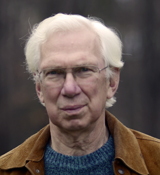

Philip Goutell
Lightyears, Inc.


